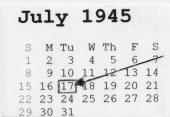![]()

[photogallery/photo00030123/real.htm]
|
The horrific day began early in the morning when 25 new Douglas twin A-26 bombers, shown in figure three, from the 310 Bomb Group took off from Okinawa carrying 100 lb bombs. Most of the planes reached Shanghai around noontime, flying above a solid overcast that made visibility of their respective targets impossible. The only lead available to the bombardier was the approximate flying time from Okinawa to Shanghai. As a result, some of the 263 bombs dropped on Shanghai landed inside the populated Hongkew Ghetto. A more detailed account of the devastation caused by the stray bombs was printed in the weekly newspaper, "Our Life," National Independent Organ of Jewish Thought, shown in figure four. The following are some personal reactions of children to the bombardment as it occurred, recalled fifty-three years later by the same three Shanghailanders. "I wonder if anyone remembers being in Kadoorie School during the bombardment and hiding under our desks? I was ten years old at the time and have very vivid memories of the incident. My father came to get me during the bombardment and when it was over he carried me home, to avoid seeing the injured and corpses he covered my head and kept repeating, "Close your eyes." (Ruth Spiegler, June 98) "There has never been a July l7~" that I do not recall the bombardment. Like you, I remember hiding under the desk at the Kadoorie School. I do a great deal of lecturing to junior high and high school students about the Holocaust, and never fail to tell them the story of July 17, 1945." (Doris Fogel, August 98) "I was attending Kadoorie School where a lunch program had just started the day before for the children and I was to stay there for lunch. For some reason I just did not want to stay so I went home. My parents were both at home, my brother never used to come home for lunch, but that day he did. It was very unusual for all of us to be home at the same time since my father and brother would be at work. All of a sudden the bombs were falling. The four of us embraced in a circle, and held each other very close so that if we would have been hit, we would all be together. Everything turned pitch black, when it was over I felt like G-d protected us by holding his hands over us. I was very lucky not having to be walked home from Kadoorie School and having to see the devastation and dead on the sidewalk, like many children did. I will never forget July 17, 1945." (Lea Baumann, September, 98) Following Pearl Harbor, air-raid security in Shanghai required all windows to be covered with black-out material during the period following an air-raid alarm. The physical and war related environment was depicted in a drawing by a nine year old boy that lived in the Hongkew Ghetto when all the air-raids occurred. The drawing, shown in figure five, shows a canon and a Japanese Sentry standing guard and holding an open bayonet. Joy and jubilation spread instantly throughout Hongkew when the news about the Japanese surrender was made public. It was only a few weeks later when US. air freighters, fighter planes and bombers, that were in charge of convoy and combat missions in the China-Burma-India Theater arrived at Chiangwan airfield in the Northern part of Shanghai, carrying the American Armed Forces of Liberation. A photo of a row of C-46 air freighters, ready to be overhauled by a crew of refugee mechanics posing in a jeep, is shown in figure six. A photograph of a four-engine US. bomber with my stepfather, Victor Stummer, standing in front of the plane, is shown in figure seven. Chiangwan airfield was one of the targets sought by US. Air Force to be bombed on the 17th of July. A large building at the airfield, illustrated in figure eight, became the US. Headquarters after the American Forces arrived in Shanghai. Located in the building was the office of the American Consulate General that employed a number of civilians and Jewish refugees. Figure nine shows an identification card stating that my step-father is employed by the American Consulate General. In figure ten, we see a group of refugee workers, including my stepfather, posing with US. Air Force officers and crew in front of the building. Salaries paid to civilians by the US. Armed forces in Shanghai were high, affording a very comfortable living for many refugees after the war. Friendship with the US. Forces was made very fast, as shown in a photograph in figure eleven. Here we see a young American sailor visiting a Jewish refugee in a typical house-lane as other refugees were curiously looking on.
The exhilaration, seeing the first American
soldier that entered the Hongkew area can be best described by quoting the
late Rabbi Fein. Rabbi Fein was a US. Chaplain, sent to Shanghai by General
Wiedemyer immediately after the war to investigate the condition of Jewish
refugees, allegedly incarcerated by the Japanese. Special thanks to Andreas Heinsius and Joan Deman for donating their material.
|